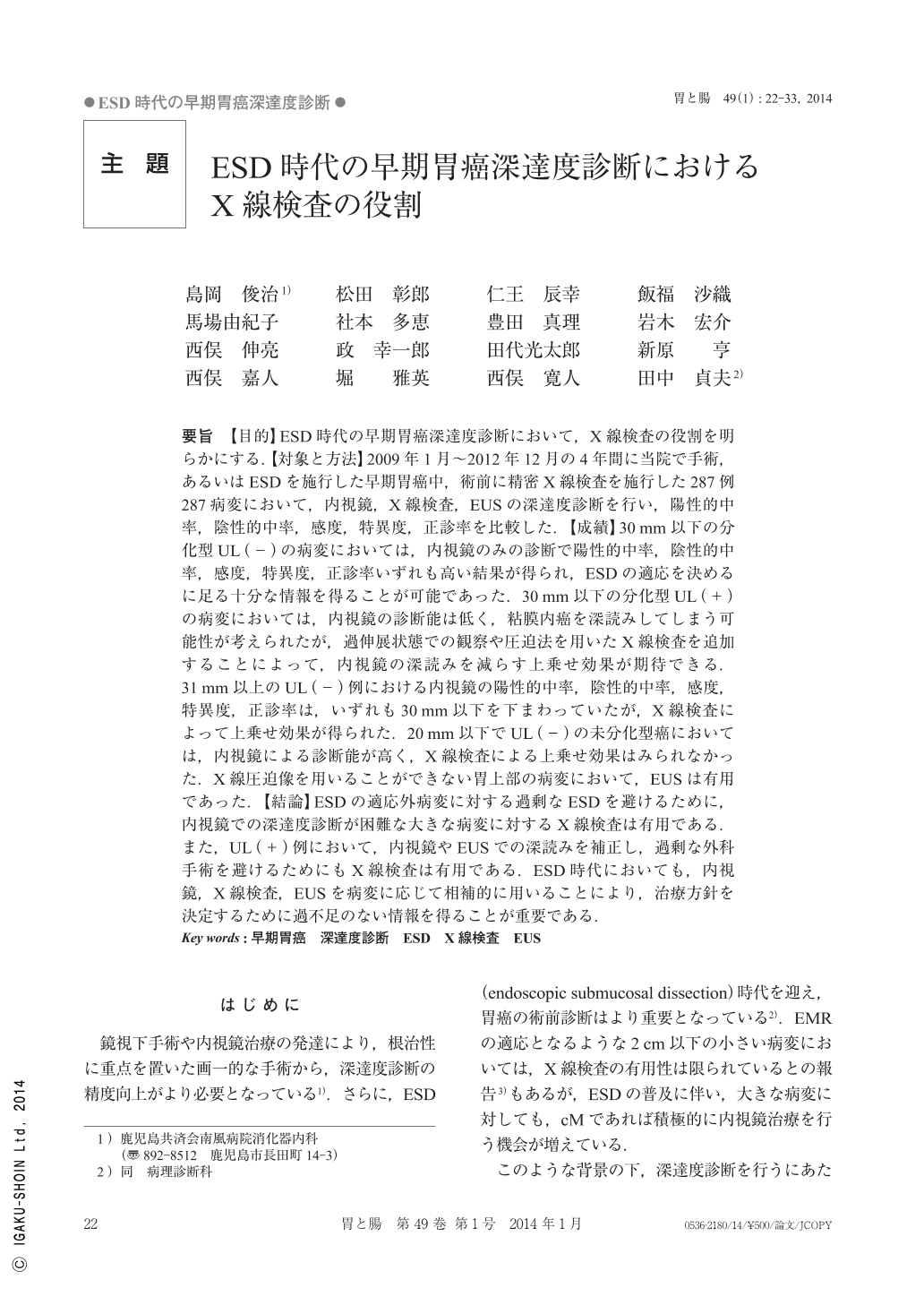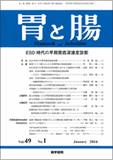Japanese
English
- 有料閲覧
- Abstract 文献概要
- 1ページ目 Look Inside
- 参考文献 Reference
- サイト内被引用 Cited by
要旨 【目的】ESD時代の早期胃癌深達度診断において,X線検査の役割を明らかにする.【対象と方法】2009年1月~2012年12月の4年間に当院で手術,あるいはESDを施行した早期胃癌中,術前に精密X線検査を施行した287例287病変において,内視鏡,X線検査,EUSの深達度診断を行い,陽性的中率,陰性的中率,感度,特異度,正診率を比較した.【成績】30mm以下の分化型UL(-)の病変においては,内視鏡のみの診断で陽性的中率,陰性的中率,感度,特異度,正診率いずれも高い結果が得られ,ESDの適応を決めるに足る十分な情報を得ることが可能であった.30mm以下の分化型UL(+)の病変においては,内視鏡の診断能は低く,粘膜内癌を深読みしてしまう可能性が考えられたが,過伸展状態での観察や圧迫法を用いたX線検査を追加することによって,内視鏡の深読みを減らす上乗せ効果が期待できる.31mm以上のUL(-)例における内視鏡の陽性的中率,陰性的中率,感度,特異度,正診率は,いずれも30mm以下を下まわっていたが,X線検査によって上乗せ効果が得られた.20mm以下でUL(-)の未分化型癌においては,内視鏡による診断能が高く,X線検査による上乗せ効果はみられなかった.X線圧迫像を用いることができない胃上部の病変において,EUSは有用であった.【結論】ESDの適応外病変に対する過剰なESDを避けるために,内視鏡での深達度診断が困難な大きな病変に対するX線検査は有用である.また,UL(+)例において,内視鏡やEUSでの深読みを補正し,過剰な外科手術を避けるためにもX線検査は有用である.ESD時代においても,内視鏡,X線検査,EUSを病変に応じて相補的に用いることにより,治療方針を決定するために過不足のない情報を得ることが重要である.
Aims : To clarify the role of radiological examination in diagnosis of the depth of invasion of early gastric cancer in the ESD age.
Methods : We investigated 287 early gastric carcinoma cases that had been treated by ESD or surgery. Endoscopic, Radiological, EUS findings that indicated SM2 carcinoma were set beforehand respectively. The accuracy of the diagnosis and the additional diagnostic value of radiological and EUS diagnosis were investigated.
Results : The accuracy rates of endoscopic diagnosis were high enough to decide the indications of ESD in the lesions 30mm or less in size that were differentiated type without UL. However in the lesions larger than 30mm and differentiated type with UL, the accuracy rates were lower than in the lesions without UL because of over-diagnosis. Even in such lesions, using radiological diagnosis, the accuracy rates rose enough to decide the indication of ESD. The accuracy rates of endoscopic diagnosis in the lesions larger than 30mm, differentiated type without UL were lower than in the lesions equal or less than 30mm because of under-diagnosis. The accuracy rates rose using radiological diagnosis in such lesions. In the lesions equal to or less than 20mm, and in undifferentiated types without UL, the accuracy rates of endoscopic diagnosis were high enough to decide the indications of ESD. EUS was useful in the upper gastric lesions where compression methods could not be used in radiological examinations.
Conclusions : Radiological examinations were useful(in large lesions that were under-diagnosed in endoscopy)to avoid unnecessary ESD and in the lesions without UL(that were over-diagnosed in endoscopy)to avoid unnecessary surgery. Even in the ESD age, it is important to use endoscopy, radiological examination, and EUS complementarily according to the types of lesions to get sufficient information for deciding treatment strategy.

Copyright © 2014, Igaku-Shoin Ltd. All rights reserved.


